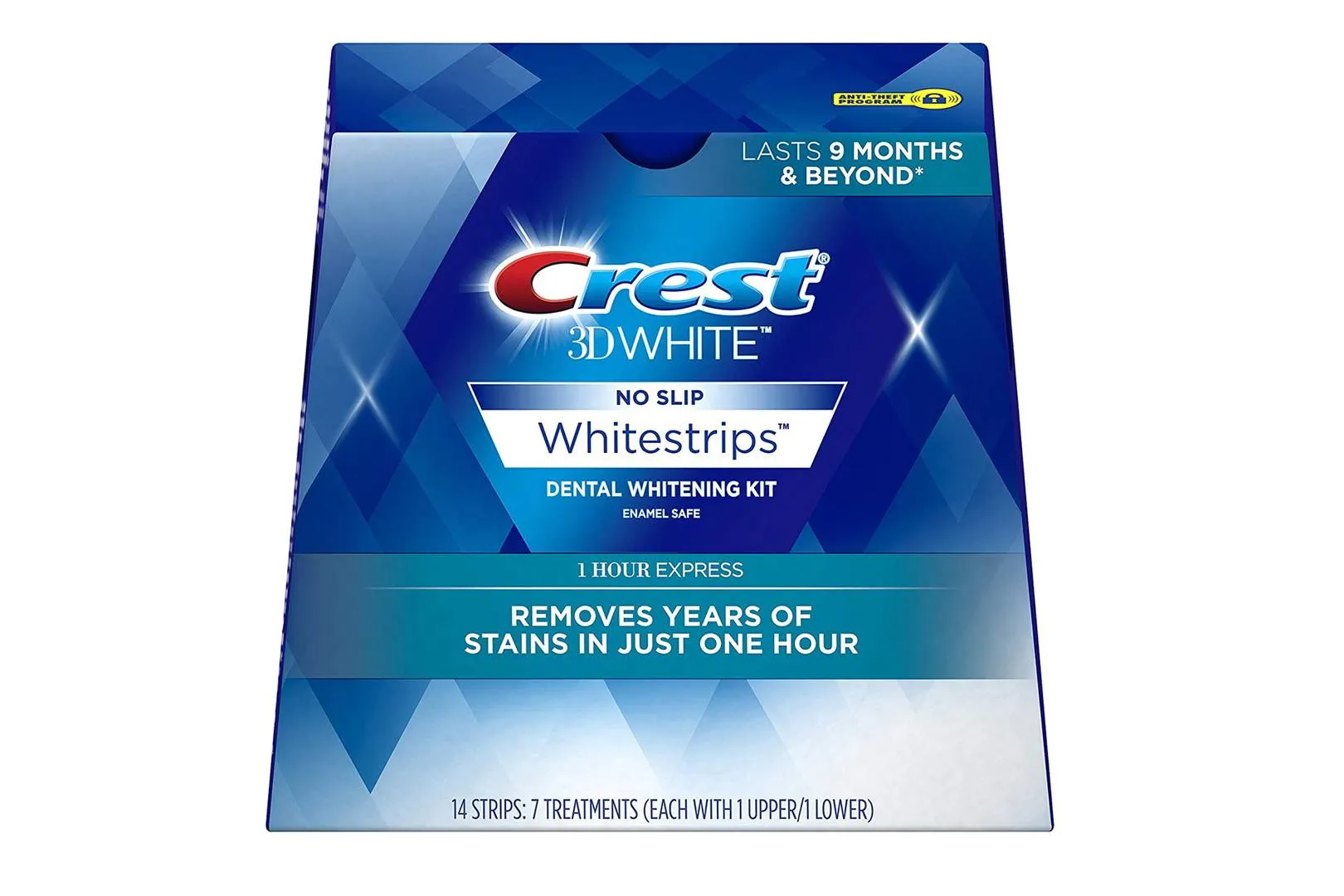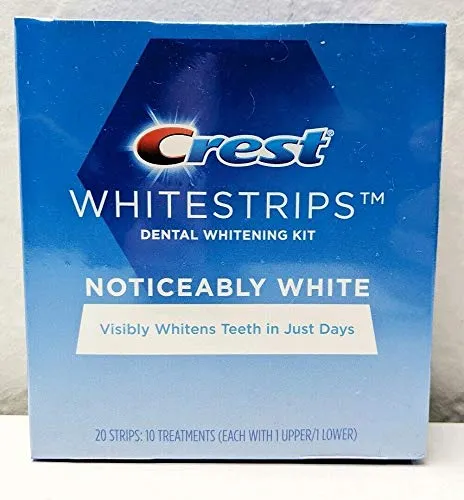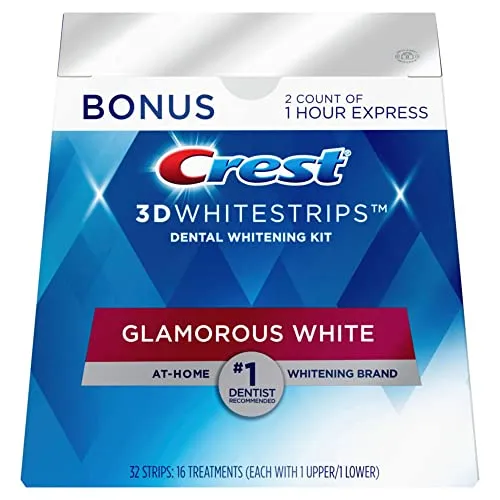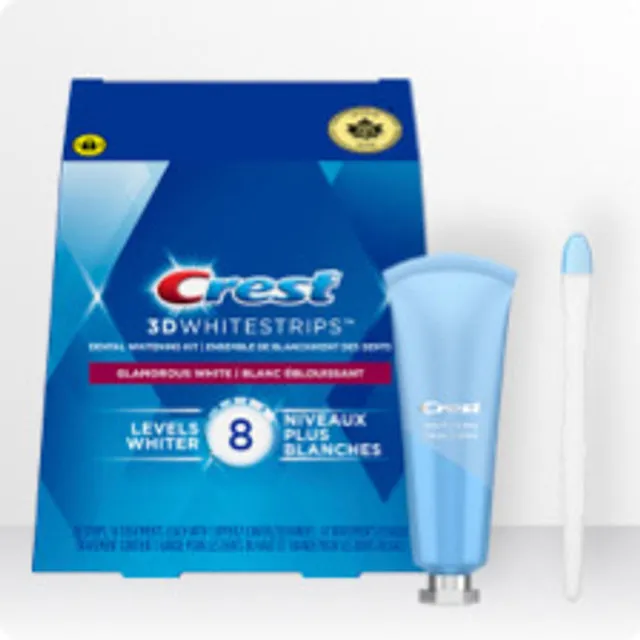What are Crest Whitening Strips?
Crest Whitening Strips have become a popular over-the-counter teeth whitening solution for those looking to brighten their smiles at home. These thin, flexible strips are coated with a whitening gel and designed to adhere directly to the teeth. They are a convenient alternative to professional whitening treatments and whitening toothpastes, offering a relatively easy way to address tooth discoloration caused by factors such as aging, coffee, tea, and tobacco use. The strips come in various formulations, each promising different levels of whitening power, allowing consumers to choose a product that best suits their needs and preferences. Understanding the basic function and components of these strips is crucial when determining their effectiveness and safety profile.
How Do Crest Whitening Strips Work?
The mechanism behind Crest Whitening Strips’ effectiveness lies in the chemical reaction between the whitening agent, typically hydrogen peroxide, and the stains present on the tooth enamel. When the strip is applied to the teeth, the hydrogen peroxide penetrates the enamel, breaking down the stain molecules. This process does not remove the enamel itself but instead lightens the appearance of the teeth by oxidizing the discolored compounds. The contact time, usually ranging from 30 minutes to an hour depending on the product, allows the active ingredient to work effectively. Regular use, as per the instructions, helps achieve the desired whitening results over a period of days or weeks. The overall effectiveness also depends on individual factors such as the type and extent of the staining, as well as the concentration of hydrogen peroxide in the strips.
The Active Ingredients in Crest Whitening Strips

The primary active ingredient in most Crest Whitening Strips is hydrogen peroxide, a strong oxidizing agent. The concentration of hydrogen peroxide varies among different Crest strip products, affecting the whitening power and potential for side effects. Higher concentrations may yield faster and more dramatic results but may also increase the risk of tooth sensitivity. Other ingredients often include stabilizers and binders to ensure the gel adheres to the teeth and remains effective throughout the treatment duration. These ingredients are designed to facilitate the whitening process while ensuring the strips are easy to use and remain in contact with the teeth. Consumers should carefully review the ingredient list on the packaging, particularly if they have sensitivities to specific chemicals.
How Effective Are Crest Whitening Strips?
The effectiveness of Crest Whitening Strips can vary depending on several factors, but generally, they are quite effective in lightening teeth and reducing surface stains. Many users report noticeable improvements in their smile’s brightness after following the recommended treatment plan. Results often become apparent within a few days of use, with more significant changes occurring over a couple of weeks. However, the extent of the whitening depends on the severity and type of stains. Superficial stains caused by food and beverages are often easier to remove than intrinsic stains, which may require professional treatments. While Crest strips can provide considerable whitening, they may not achieve the same dramatic results as in-office dental procedures. For optimal outcomes, adherence to the product instructions and consistency in application are key.
Factors Affecting Whitening Results
Several factors can influence the effectiveness of Crest Whitening Strips. The type and severity of tooth staining play a crucial role, with stains from coffee, tea, and tobacco often being more responsive than intrinsic stains. The original shade of the teeth also matters; individuals with naturally darker teeth may experience less dramatic whitening compared to those with lighter shades. The consistency of use is also crucial; skipping applications or not following the prescribed duration can reduce the effectiveness. Additionally, lifestyle choices such as continued consumption of staining foods and beverages can impact the results. Maintaining good oral hygiene, including regular brushing and flossing, helps maximize the whitening effects. Understanding these influencing factors helps manage expectations and optimize outcomes.
Benefits of Using Crest Whitening Strips

Crest Whitening Strips offer several benefits, making them a popular choice for teeth whitening. They are a convenient and cost-effective alternative to professional treatments. The ability to whiten teeth at home allows users to integrate the treatment seamlessly into their daily routine, saving time and money. These strips are readily available over the counter, making them accessible to a wide range of consumers. Regular use can significantly improve the appearance of the smile, boosting confidence and providing a more youthful appearance. The ease of use and the availability of various formulations catering to different needs make them a versatile option for those seeking whiter teeth.
Improved Smile Aesthetics
One of the primary benefits of using Crest Whitening Strips is the noticeable improvement in smile aesthetics. Whiter teeth create a brighter and more attractive smile, which can enhance self-esteem and social interactions. Removing stains and lightening the teeth can make a person look younger and healthier. This improvement in appearance can boost confidence in personal and professional settings. For many, the positive impact on their appearance motivates continued use and supports a more positive self-image. Seeing the gradual transformation of the smile often provides significant satisfaction.
Convenience and Ease of Use
Crest Whitening Strips are highly valued for their convenience and ease of use. The simple application process involves adhering the strips to the teeth for a specified time, making it easy to incorporate teeth whitening into a busy lifestyle. No special equipment or professional assistance is required. The strips can be used at home or on the go, making them ideal for maintaining a bright smile. This convenience allows users to achieve whiter teeth without the hassle of dental appointments or the expense of professional treatments. The simplicity of the application process encourages consistent use, thus maximizing the whitening results.
Potential Side Effects of Crest Whitening Strips

While Crest Whitening Strips are generally safe, they can cause some side effects. The most common side effects are tooth sensitivity and gum irritation, which are typically temporary and subside once the treatment is completed or the frequency of use is reduced. Other, less frequent side effects include changes in the texture of the tooth enamel, although this is usually minor and reversible. It is important to be aware of these potential side effects and to take steps to minimize their impact. Consulting with a dentist before starting treatment can help ensure that Crest strips are suitable for your specific dental situation and help manage any potential side effects.
Tooth Sensitivity
Tooth sensitivity is a common side effect of using Crest Whitening Strips, often experienced during and after treatment. This occurs because the whitening agent, hydrogen peroxide, can penetrate the enamel and reach the dentin, the layer beneath the enamel, where the nerve endings are located. The sensitivity is usually temporary and subsides a few days after stopping or reducing the frequency of the treatments. Using a toothpaste designed for sensitive teeth, or avoiding cold or hot foods can help manage the discomfort. If sensitivity persists, it is best to consult with a dentist to ensure there are no underlying dental issues.
Gum Irritation
Gum irritation is another potential side effect, typically caused by the whitening gel coming into contact with the gum tissue. This can lead to redness, swelling, and discomfort. To minimize this, it is crucial to apply the strips carefully, ensuring they do not extend onto the gums. Trimming the strips to fit the teeth accurately can also help. If gum irritation occurs, it is advisable to reduce the frequency of use or stop the treatment temporarily. Regular rinsing with water can help to soothe the gums. If the irritation persists, seeking advice from a dental professional is recommended to rule out any other underlying issues.
How to Use Crest Whitening Strips Safely

To ensure the safe use of Crest Whitening Strips, it is essential to follow the product instructions carefully. Before applying the strips, brush and floss your teeth to remove any plaque or food particles. Apply the strips according to the directions, usually for a specified time period, and avoid touching the gums. After removing the strips, rinse your mouth with water. It is also crucial to avoid eating or drinking during the treatment and for a short period afterward to prevent staining. Stick to the recommended treatment duration, as overuse can increase the risk of side effects. If you have any dental work, such as fillings or crowns, consult your dentist before use, as the strips may not whiten these materials.
Choosing the Right Crest Whitening Strips
Crest offers a variety of whitening strips, and choosing the right product depends on your needs and preferences. Consider the level of whitening you desire and how sensitive your teeth are. Products vary in the concentration of hydrogen peroxide, with higher concentrations offering quicker results but potentially increasing the risk of sensitivity. If you have sensitive teeth, consider starting with a lower concentration or using the strips for a shorter duration. Research the product reviews to understand the experiences of other users. Some products may be designed for specific types of stains or for maintenance of whitening results. Consult with your dentist for personalized recommendations, especially if you have any underlying dental conditions.
Following Application Instructions
Adhering to the application instructions is crucial for achieving optimal results and minimizing potential side effects. Carefully read the product instructions before starting treatment. Ensure your teeth are clean and dry before applying the strips. Apply the strips correctly, making sure they adhere to the surface of your teeth and avoid contact with your gums. Follow the recommended treatment duration, typically 30 minutes to an hour, depending on the product. Do not use the strips more frequently or for longer periods than recommended. After removing the strips, rinse your mouth with water. Consistent adherence to these steps will increase the effectiveness of the treatment and reduce the likelihood of adverse effects. If any issues arise, such as increased sensitivity or irritation, review the instructions and consider consulting a dentist.
Alternatives to Crest Whitening Strips

While Crest Whitening Strips are a popular choice, other teeth-whitening alternatives exist. These include professional teeth whitening treatments offered by dentists, which often use higher concentrations of bleaching agents and can produce more dramatic results. Whitening toothpastes and mouthwashes are other options, though these typically have a lower concentration of whitening agents and provide more subtle results. Another alternative is using custom-made whitening trays provided by a dentist, which fit precisely over your teeth and allow for more even distribution of the whitening agent. The best alternative depends on your budget, desired results, and dental health. Consult your dentist to discuss the most suitable option for your needs and to get personalized recommendations.
Professional Teeth Whitening
Professional teeth whitening, performed by a dentist, is often the most effective method for achieving significant and long-lasting results. These treatments typically involve the use of higher concentrations of hydrogen peroxide or other bleaching agents. The dentist can also apply the whitening agent more precisely, protecting the gums from irritation. In-office whitening procedures can often lighten teeth by several shades in a single session. Dentists may also offer custom-fitted trays for at-home whitening treatments. While professional whitening is generally more expensive than over-the-counter options, it is often more effective, especially for severe staining or discoloration. Before undergoing professional whitening, a dental check-up is usually recommended to ensure oral health and that the patient is a suitable candidate.
Whitening Toothpastes and Rinses
Whitening toothpastes and mouthwashes are another option for those seeking to brighten their smiles. These products often contain mild abrasives or chemical agents that help remove surface stains from the teeth. While they are generally less effective than whitening strips or professional treatments, they can help maintain the results of other whitening methods and can be a cost-effective approach for everyday use. The benefits of these products include their ease of use and accessibility, as they can be incorporated into your regular oral hygiene routine. However, the whitening effects are often subtle, and it may take time to see noticeable changes. Consult your dentist before using whitening toothpastes or mouthwashes, especially if you have sensitive teeth or other dental conditions.
Are Crest Whitening Strips Suitable for Everyone?

Crest Whitening Strips are generally safe for most adults, but they are not suitable for everyone. They are not recommended for children under the age of 12. Pregnant or breastfeeding women should also consult with a dentist before using them. People with sensitive teeth or gum issues should also exercise caution. Those with existing dental work, such as fillings, crowns, or veneers, should be aware that the strips will only whiten the natural teeth, and the dental work will remain the same color. Individuals with severe tooth discoloration may not achieve the desired results with over-the-counter strips and may require professional whitening. Consulting a dentist is recommended before starting the use of any teeth whitening product, especially if you have any existing dental health conditions.
Consulting Your Dentist
Consulting your dentist before using Crest Whitening Strips or any other teeth-whitening product is highly recommended. A dentist can assess your oral health and determine if you are a suitable candidate for teeth whitening. They can identify any underlying dental issues, such as cavities or gum disease, which should be addressed before whitening. Your dentist can advise you on the most appropriate whitening options based on your specific needs and the condition of your teeth. They can also offer professional treatments and provide guidance on safe and effective use of over-the-counter products, minimizing any potential side effects and ensuring optimal results. Regular dental check-ups also provide an opportunity to monitor your oral health and make any necessary adjustments to your teeth-whitening routine.
In conclusion, Crest Whitening Strips can be a good option for improving the brightness of your teeth. However, understanding their effectiveness, potential side effects, and suitability for your situation is crucial. Consulting your dentist is the best way to ensure safe and successful teeth whitening. By considering these factors and following the guidance of dental professionals, you can confidently achieve a brighter, more confident smile.
